Recent Articles
Popular Makes
Body Types
2022 Infiniti QX60 vs. 2022 Lexus RX
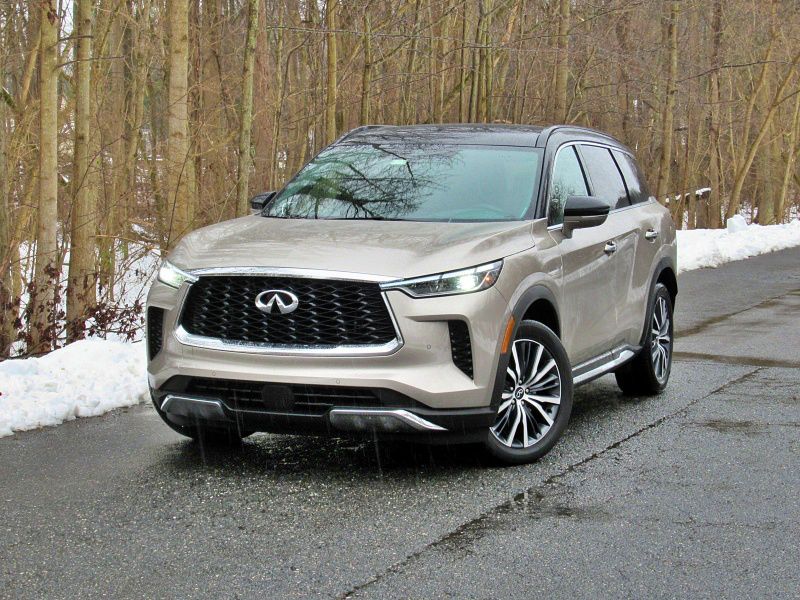
2022 Infiniti QX60 Autograph ・ Photo by Brady Holt
If you’re interested in a mid-size luxury crossover, odds are you’ve considered the Lexus RX. Not only is it the class’s best-seller, but it’s often America’s best-selling vehicle of any traditional luxury brand — period.
But especially if you’re interested in three rows of seats, there’s a tempting new competitor to the RX. That’s the freshly redesigned 2022 Infiniti QX60. Both the RX and the QX60 trace their mechanical components to mainstream-brand vehicles (the Toyota Highlander and Nissan Pathfinder, respectively), but they have the style and features to command premium prices. For this review, we tested the RX and QX60 to compare them in each of eight categories and then name an overall winner. Keep reading to learn which one we chose and see which sounds like the better option for you.
Exterior Design
The RX and QX60 look about as different as you can get from two similarly sized SUVs. Although the current-generation RX has changed little since way back in 2016, it’s still polarizing and fresh. The five-seat model’s swoopy hatchback-like shape was ahead of the “SUV coupe” curve. And while the three-row RX L model (pictured on this page) has a bigger, boxier, and generally more conventional rear end, you still get Lexus’s big hourglass-shaped “spindle” grille that drops down from two high, slim headlights. The Lexus is also available in bold colors like Matador Red and Grecian Water blue.
The QX60, meanwhile, embraces subtlety. Instead of sharp edges, it has gentle curves. Instead of lots of details, Infiniti favored simplicity. And where the RX is aggressive and sporty-looking, the QX60 is soothing and gentle. The Infiniti is 3.4 inches wider than the RX, a substantial difference that gives it more presence when viewed head-on. On the other hand, the QX60 shares more visual similarity with its Nissan Pathfinder cousin than the RX shares with the Toyota Highlander. We’ll let you choose between the subtler QX60 and the more distinctive, more aggressive RX.
Tie
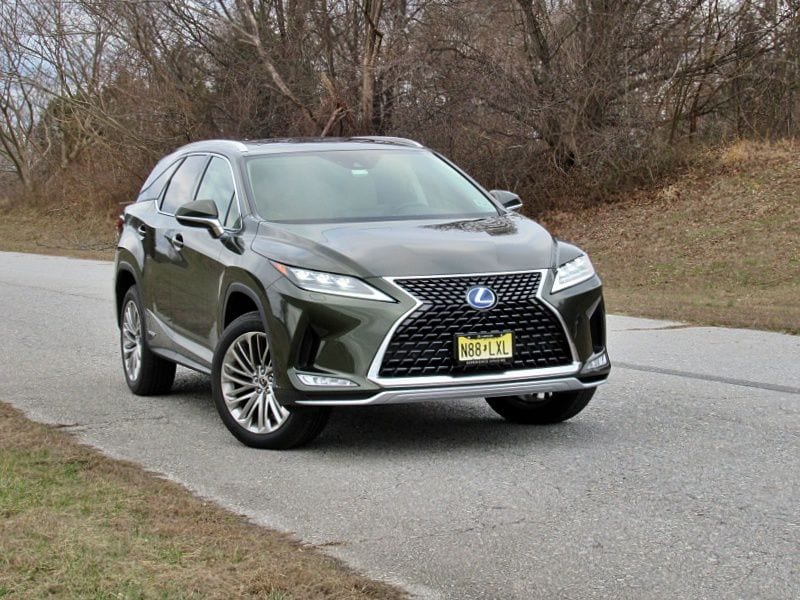
Photo by Brady Holt
Interior Design
The QX60’s interior is just about what you’d expect from the exterior: elegant and graceful. A big 12.3-inch touchscreen infotainment system sits atop the dashboard, floating in a leather-lined sea atop a middle section of the dash. Other controls cluster farther down and on the console between the front seats. Materials are indisputably posh and moving parts move smoothly.
The RX’s interior design is more like the QX60’s than you might expect, with a similarly curved dashboard shape and infotainment screen placement. But a couple of differences lead us to prefer the Infiniti. First, while the Lexus is available with a 12.3-inch touchscreen, a smaller 8-inch unit is standard. Secondly, the RX suffers from too many downscale interior plastics, harshly glowing warning lights on the gauge cluster, and an ear-piercingly shrill warning chime. The QX60’s infotainment display is less customizable than the Lexus’s, and the screen’s graphics are also straight out of Nissan — with bright colors and simple shapes that can feel out of place in this high-end cabin. And we didn’t love the QX60’s sea of hard-to-distinguish touch-sensitive buttons on the lower dashboard. Still, while not perfect, the Infiniti is more luxurious inside.
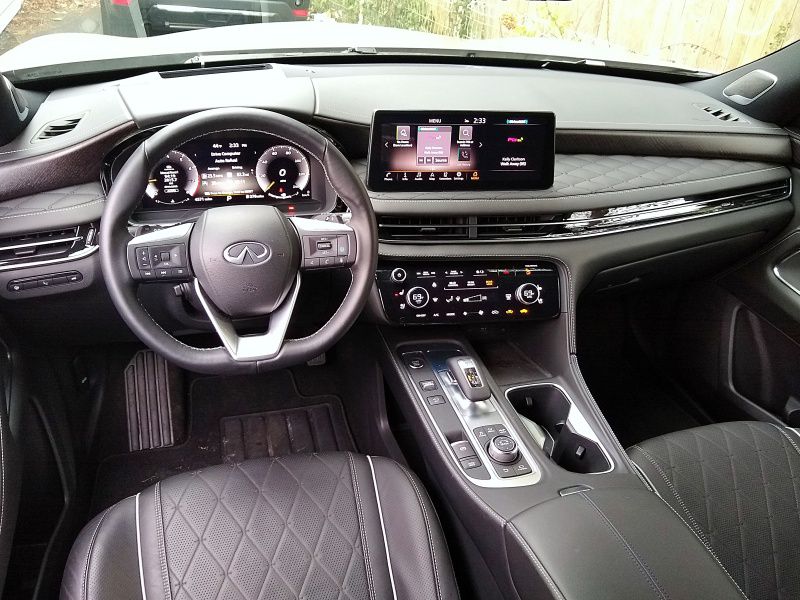
Photo by Brady Holt
Passenger Accommodations
The QX60 is 1.3 inches longer, 3.4 inches wider, and 2.4 inches taller than the RX L, and it’s 5.7 inches longer than the two-row RX. So it’s no surprise that the Infiniti has a roomier interior. The surprise is how large its advantage is.
If you’re planning on using a third-row seat, the RX L is barely usable even by the low standards of a mid-size SUV. What’s more, wedging in a third row leaves little space even for the second row; the standard RX has substantially more second-row legroom than the RX L. By contrast, the QX60 is more typical for the class: The third row is cramped, but adults can fit if you slide the second row forward a bit. And we had no complaints in either of the first two rows. Both SUVs have comfortable front seating, but unless you’re attached to the more heavily bolstered front seats on the two-row-only RX 350 F Sport model, Infiniti takes this category easily.
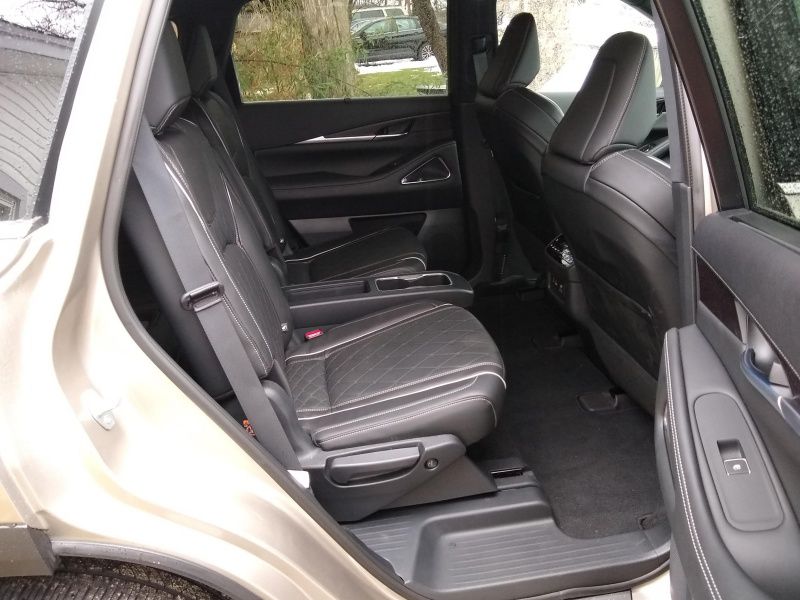
Photo by Brady Holt
Cargo and Utility
The QX60 doesn’t have a massive cargo capacity for a mid-size three-row crossover. It holds 15 cubic feet of cargo space behind the third row, 42 cubic feet with its third row folded down, and 75 cubic feet with both the second and third rows folded. That’s plenty useful, but some competitors have more.
The RX isn’t among them, though. The RX L fits a tiny 8 cubic feet behind its third row, 22 cubic feet behind its second row, and 59 cubic feet behind its front seats. The two-row RX holds even less: 18 cubic feet of cargo behind its rear seat and 56 cubic feet with the rear seat folded. That’s less than some subcompact crossovers, two sizes down from the RX and QX60. The Infiniti tows more, too: up to 6,000 pounds versus the Lexus’s 3,500-pound towing capacity.
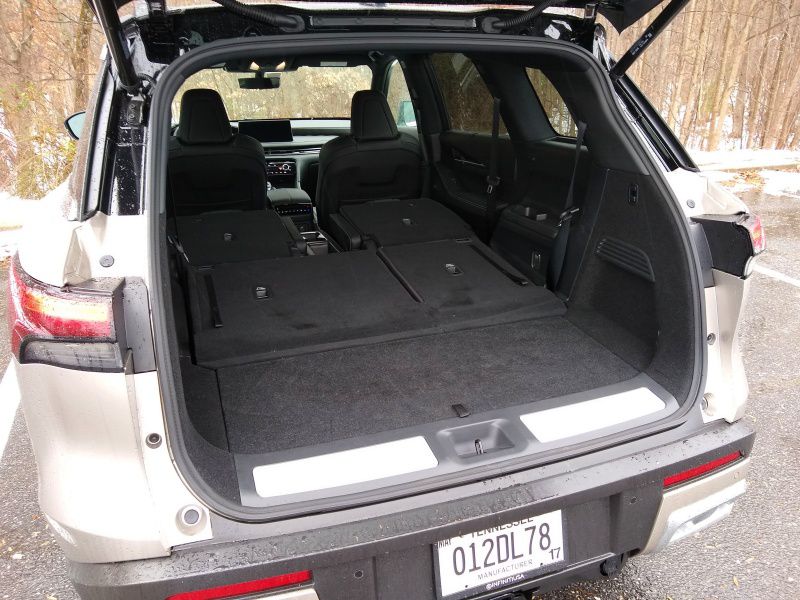
Photo by Brady Holt
Driving Impressions
The RX’s aggressive styling and available F Sport model suggest this is a driver’s SUV — something invigorating. And Lexus’s reputation promises the opposite: something hushed and comfort-focused. Instead, the RX didn’t blow us away on either count. It’s decently comfortable and quiet, sure, but nothing incredible for a luxury car. And while it’s more agile than past RX generations, even the F Sport isn’t a superstar (and the three-row RX L lacks an F Sport model). Choose between two equivalently smooth and powerful V6 engines: the RX 350’s 295-horsepower gas-only motor and the RX 450h hybrid’s 308-hp gas-electric powertrain.
We preferred the QX60 for several reasons. Its suspension is firmer than the Lexus’s, but it rides with more composure; bumps don’t threaten to upset it, even if you do feel them. Its firm, natural-feeling steering also inspired more confidence. Both are big improvements over last year’s QX60. So is the powertrain: The 295-horsepower V6 engine carries over from the previous generation, but it’s now paired with a crisp-shifting nine-speed automatic transmission.
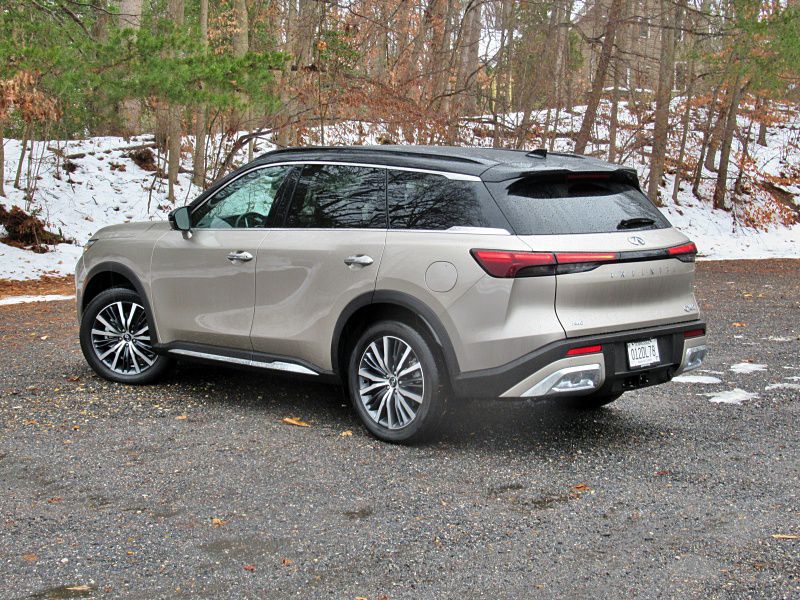
Photo by Brady Holt
Fuel Economy
The 2022 Infiniti QX60 earns an EPA-estimated 21 mpg in the city, 26 mpg on the highway, and 23 mpg combined with front-wheel drive, and 1 mpg less with all-wheel drive. Those are great numbers for a three-row V6 SUV, and we edged out the EPA estimate to average 23 mpg in our AWD test vehicle.
The equivalently sized RX 350L averages 19 mpg city, 26 mpg highway, and 22 mpg combined with front-wheel drive and 1 mpg less with AWD. The two-row front-drive model improves to 20 mpg city, 27 mpg highway, and 23 mpg combined (1 mpg less with AWD) — still only a tie with the bigger QX60. And we averaged just 20 mpg in a two-row AWD RX 350. Still, we’ll give the Lexus the win for two reasons: First, the RX 350 uses less expensive regular-grade fuel while the QX60 wants premium. Secondly, only the Lexus is available as a hybrid. The RX 450h’s EPA ratings rise to 31 mpg in the city, 28 mpg on the highway, and 30 mpg combined, while the three-row RX 450hL gets about 1 mpg less. It uses premium fuel, but our RX 450hL test vehicle matched that 29 mpg estimate.
Lexus RX
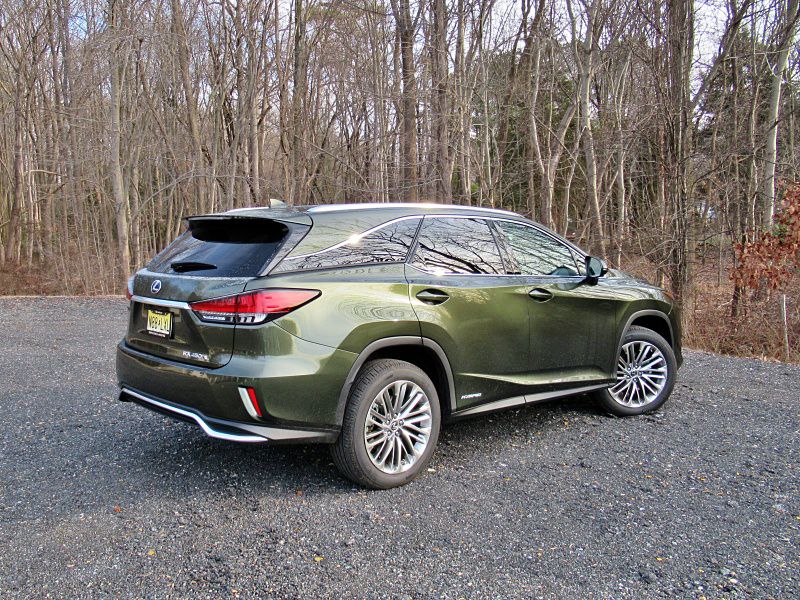
Photo by Brady Holt
Safety
The Infiniti QX60 comes standard with numerous advanced driver aids, including automatic emergency braking, a lane-departure warning, and blind-spot monitoring. But the Lexus RX adds more advanced driver aids to the base model: lane-keeping steering assistance and adaptive cruise control. These cost extra on the Infiniti. On the other hand, only the QX60 offers a rearview camera mirror that can eliminate rear blind spots.
Meanwhile, the QX60 and RX both earned mostly excellent scores from the Insurance Institute for Highway Safety. The exception is that most RX headlights received the lowest score of Poor while the QX60’s weren’t tested at all, and the Infiniti scored slightly better at automatically braking to avoid a pedestrian. The National Highway Traffic Safety Administration hasn’t yet tested the QX60, but the RX scored a mediocre four out of five stars. Between the Lexus’s additional standard safety features, the Infiniti’s slightly better IIHS showings, the Lexus’s weak NHTSA score, and the Infiniti’s unproven abilities in those same tests, we’ll call this category a tie.
Tie
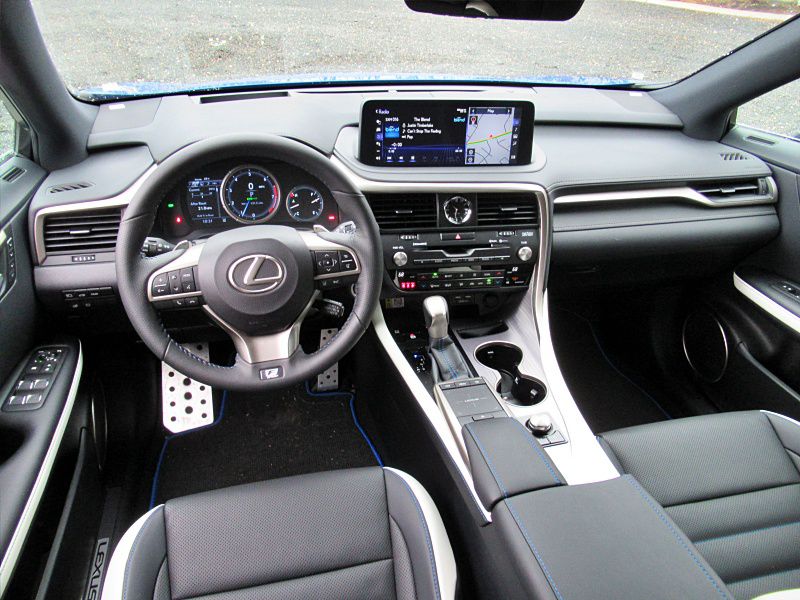
Photo by Brady Holt
Pricing and Features
Here’s another tie, where various data points fail to point us conclusively one way or the other. On the one hand, the cheapest 2022 Lexus RX costs $45,570 versus the 2022 Infiniti QX60’s base price of $46,850. On the other hand, the more equivalently sized RX 350L rises to $48,400.
Then there’s the matter of standard equipment. The Infiniti wins on luxury features: genuine leather seats instead of the Lexus’s leatherette, heated front seats, a heated steering wheel, a panoramic sunroof, and its biggest 12.3-inch infotainment screen. But the base QX60 is missing the RX’s standard driver aids we mentioned on the previous page: adaptive cruise control and lane-keeping steering assistance. Our advice is to keep your eye on specific features you’re interested in having, since one might be available on a low-range RX but limited to a top-trim QX60 or vice versa. Your own priorities determine this winner.
Tie
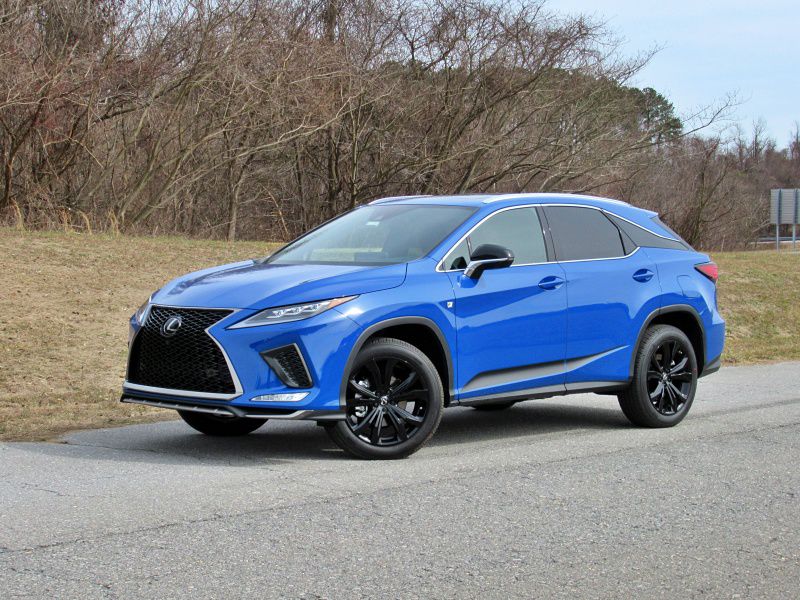
Photo by Brady Holt
Final Thoughts
The Lexus RX is a perennial favorite. It’s a comfortable, quiet crossover that packs a visual punch while offering a lower starting price than most mid-size luxury suvs. And it’s available with a powerful yet fuel-efficient hybrid powertrain.
But the QX60 is our pick. The Infiniti supplies more room, richer interior materials, and superior driving manners. The QX60 could have simpler controls and a fancier-looking infotainment system. And depending on the features you’re looking for, it can cost more than the RX. On the other hand, the reverse is also true. And either way, the Infiniti justifies its higher price. If you aren’t particular about maximum interior space, and you have a stop-and-go commute that would showcase the RX hybrid’s peak mileage conditions, we’d recommend giving the Lexus serious thought. Otherwise, we’d recommend the Infiniti first.
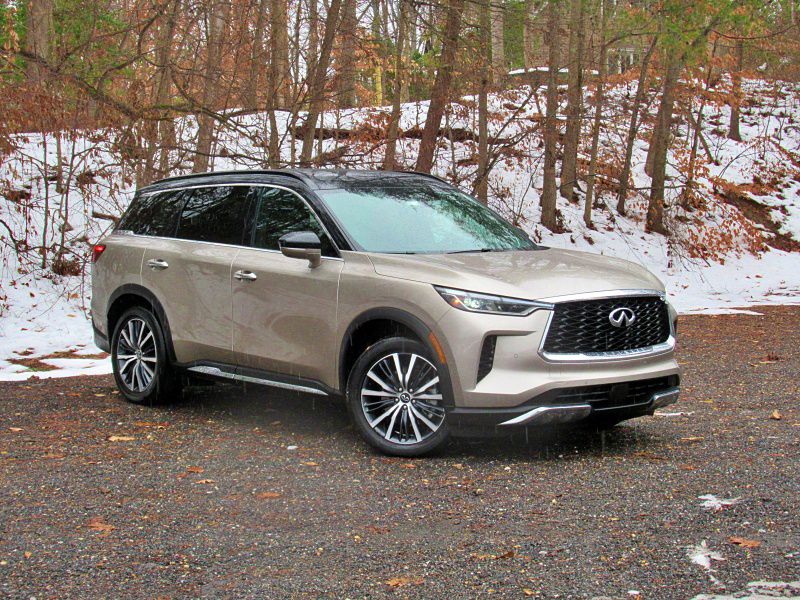
Photo by Brady Holt